
Update: Check out Ria's post on the things she discovered at the wildfilms blog.
I woke up early this morning to join Ria on a trip to explore the sandy shores of East Coast. Not many people know that although the beaches of East Coast Park are artificial, there is still quite a lot of marine life to be found in the inter-tidal zone.
Unfortunately, the tide was a bit too high for our liking, so we did not manage to find a lot of things, such as the sea fans that have been seen recently. Still, we did see quite a fair amount of marine critters, as I'll show later.
But today really brought home a message about the information that can be gained from examining the flotsam and jetsam that gets washed up on the shores. Although much of what you find on East Coast Park is man-made rubbish, there are plenty of signs that point to the existence of a variety of marine life.
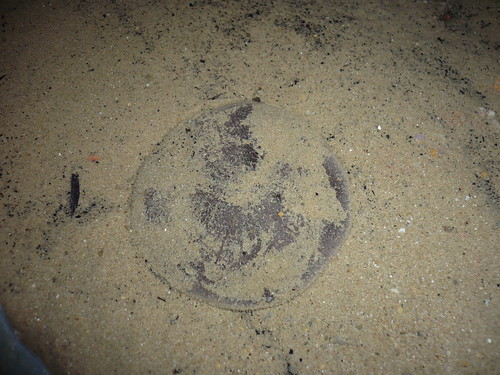
First find of the morning was this sand dollar (Arachnoides placenta). These used to be very common on our sandy shores, but are unfortunately quite rare nowadays, being restricted to places such as Chek Jawa and Cyrene Reef. Believe it or not, sand dollars actually belong to the same group as the spiny sea urchins.

Here's a relatively common inhabitant of our northern shores - an orange striped hermit crab (Clibanarius infraspinatus).

I turned over a rock, and was thrilled to find a pair of tiny creatures that I'd seen before only in books - chitons!
Most people would be familiar with 3 main groups of molluscs, namely the Gastropoda (abalone, limpets, snails, slugs, sea butterflies and nudibranchs), Bivalvia (clams, scallops, oysters and mussels), and Cephalopoda (nautilus, cuttlefish, squid and octopus), when in fact there are 8 living groups of molluscs. One of these lesser-known groups is the Polyplacophora, known as chitons.

Chitons are quite similar to snails, in that they have a muscular foot, with a mouth on the bottom. Like many of the snails found on rocky shores, most species of chiton live on or under rocks, scraping off algae and other tiny organisms with their radula ('tongue'). However, unlike gastropods, their shell is very different; it's made up of eight separate overlapping plates which give it some flexibility. Some species can actually curl up into a ball when dislodged!
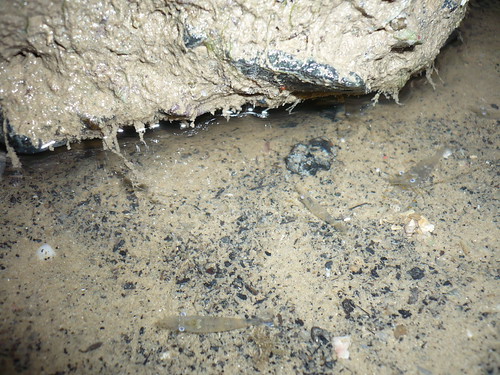
The rocks here are a shelter for many other creatures, such as these tiny glass shrimp.
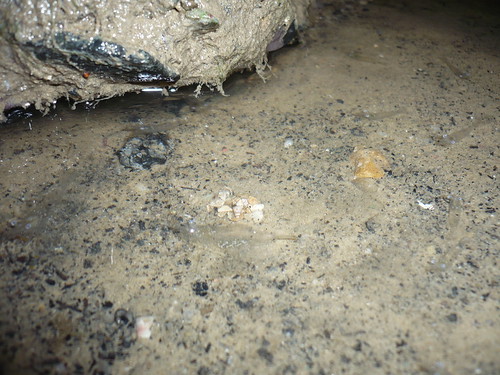
Here's a little game: How many shrimp can you find in this photo? I see 9. How about you?

We were a little surprised to bump into this fellow. It's a gold-spotted mudskipper (Periophthalmus chrysospilos). These adaptable guys can sometimes be found even on sandy and rocky shores. I've personally seen them in the artificial lagoons created along Siloso Beach.
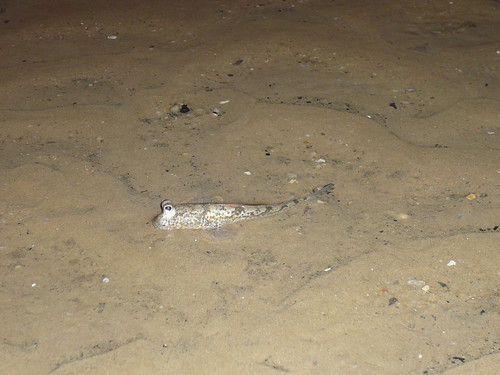
Mudskippers seem to be less skittish at night.
We managed to spot a swimming crab which isn't seen very often, but it vanished beneath a rock before I could snap a photo. It's possibly Charybdis annulata.
A great way to see what species of snails inhabit the area is to examine the local hermit crabs. Because hermit crabs have to continually upgrade to larger shells as they grow, they depend on a constant supply of shells.
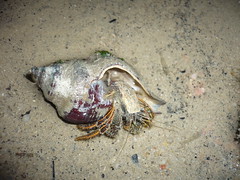


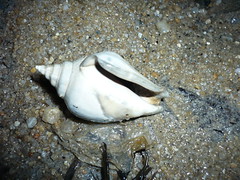
Here we have 4 different hermit crabs of the same species, occupying the shells of 4 species of snail. Upper left: spiral melongena (Pugilina cochlidium). Upper right: dwarf turban shell (Turbo bruneus). Lower left: drill (Thais sp.). Lower right: pearl conch (Laevistrombus turturella) (I know it looks empty, but there was a hermit crab hiding inside, I swear).
We saw glimpses of the tips of a red sea fan, but the tide was too high, and the water was too murky, so we gave up and decided to head further down to another section of beach.


This is the shell of a huge Arabian cowrie (Cypraea arabica). Cowries are now rather rare due to overcollection for their beautiful shells, so it's fascinating to find evidence that such large cowries still exist in our waters.
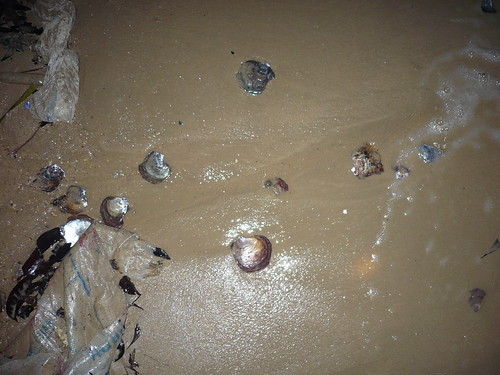
Countless oyster shells are being washed up onto the shore. What could explain the presence of so many oyster shells?
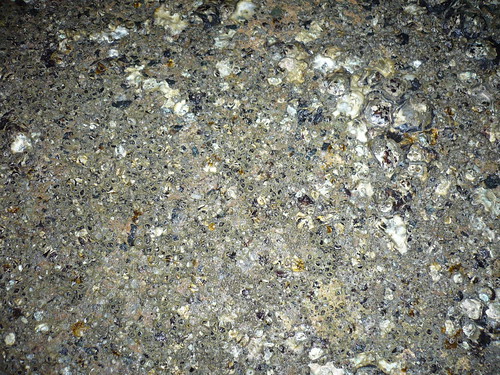
The granite breakwaters have become a home for many of the creatures that live on rocky shores, such as barnacles and limpets.
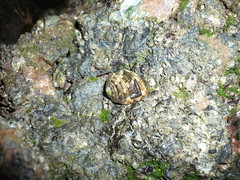
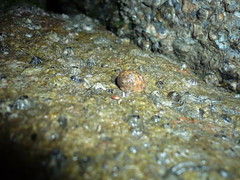
Nerites (Nerita chamaeleon?) can be found as well. Remind me to take photos of the underside of the shells - shell colour can be highly variable, so sometimes looking at the columellar shelf (the flat region on the underside of the shell next to the aperture) is the only way to tell the various species apart.

Here's another game: Spot the onch (Onchidium sp.)!

Near the water's edge, a well-camouflaged topshell (Trochus maculatus).

There are huge masses of drills on the breakwaters. Are they feeding? Fornicating? Or just hanging around because they like each other's company?

Discovery of the day - seagrasses! This is the tape seagrass (Enhalus acoroides). It really raises the question - are there seagrasses growing in the waters off East Coast? Or is there some seagrass bed nearby that's being ripped up by development of some sort, resulting in all these little bits washing up on shore?
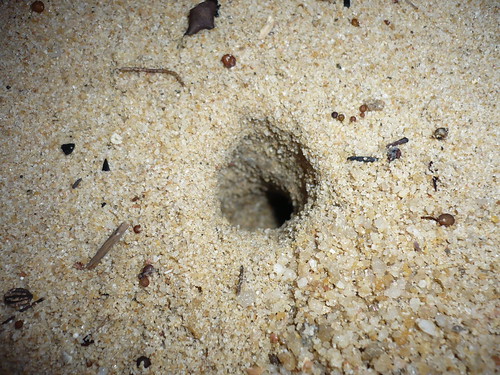
Large round burrows high up on the beach are commonly seen on our sandy shores. These are the burrows of ghost crabs (Ocypode spp.), which are very shy nocturnal scavengers. I've seen their burrows countless times, but so far the only time I've actually seen a ghost crab was at Bintan in September 2006.
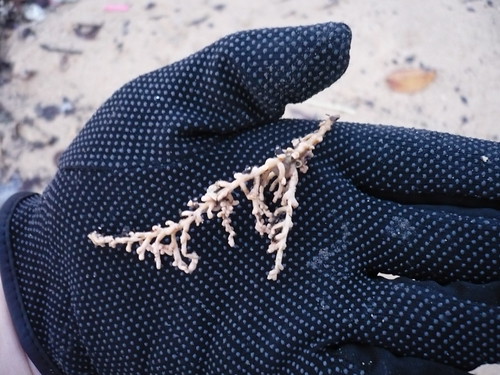
Sponge? Hydroid?
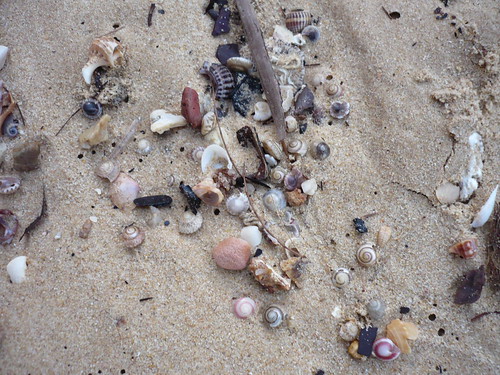
If you look carefully on the high shore, you can find lots of pretty little button shells (Umbonium vestiarum)!

There's such a wide variety of colours and patterns.

Here's the half-eroded shell of a predator of button shells - a moon snail (Polinices didyma)

And the shell of an unidentified snail.
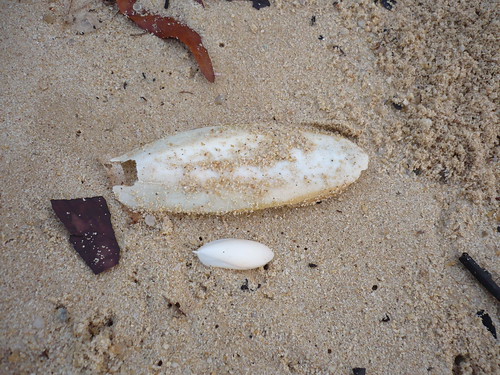
I realise that it's quite easy to find cuttlebone along the beach. The larger one is as long as my hand.
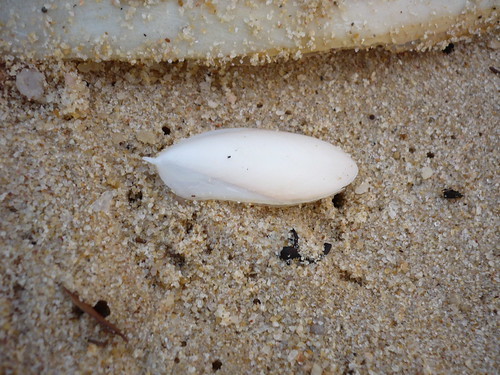
There are many animals on the beach which make a living out of scavenging. From large animals like birds and monitor lizards, to crabs, snails, and worms, to tiny critters such as springtails, amphipods, and isopods.
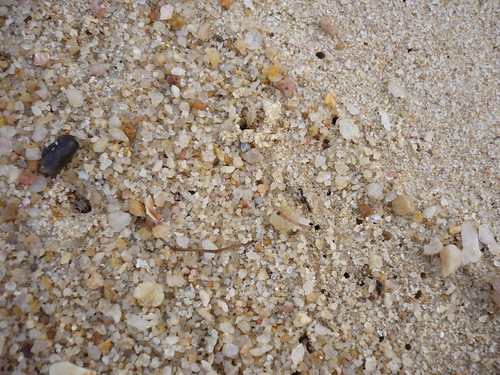
Here's another challenge for you: Please see this photo at full size. If you look very closely, you might be able to spot a couple of extremely tiny isopods. They make small burrows among the sand grains, and come out searching for dead animal matter washed up on the shore.
Give up? Here they are!

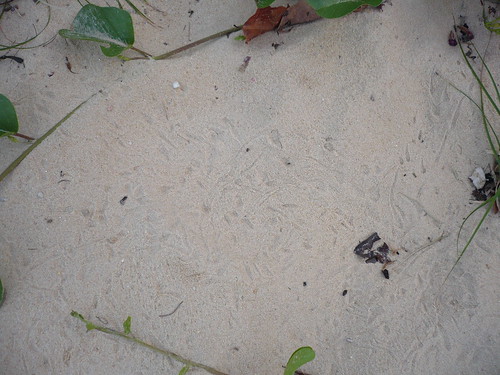
Are these little tracks in the sand made by ghost crabs? Or maybe even land hermit crabs (Coenobita spp.)?
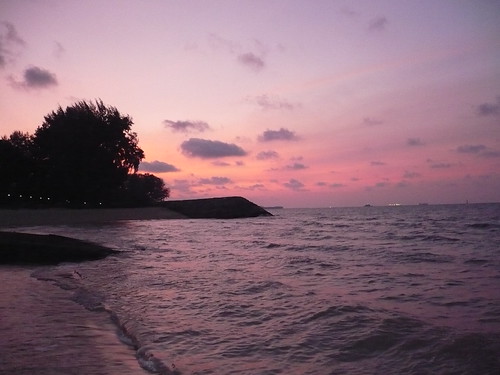
It's a beautiful morning.
But being out here early in the morning means that one gets to see an ugly side of East Coast - the pollution that comes about from all the litter and trash.
The cleaners are already out and about before dawn, and this is what they have to deal with every morning:
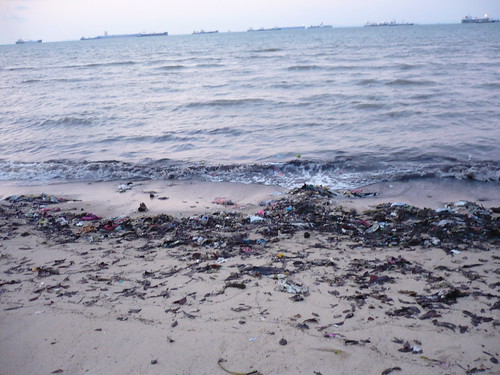
True, quite a bit of the rubbish that's washed up is organic in nature, but there's a depressingly huge amount of plastic.
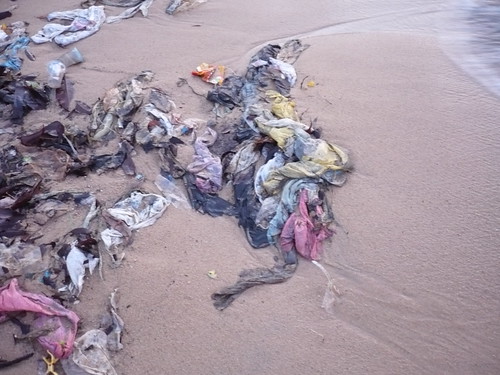
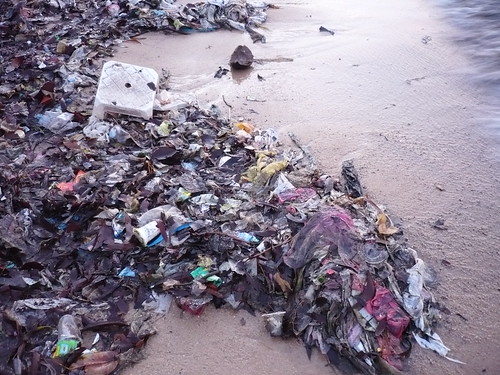
And it's not difficult to see the source of some of this garbage:
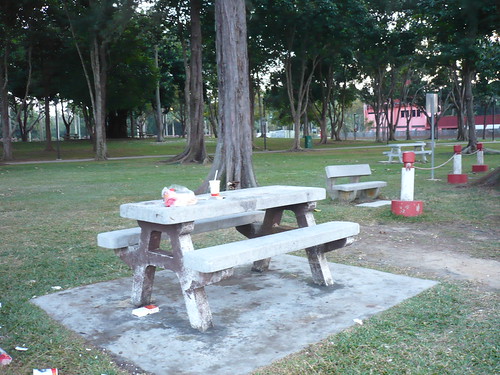
I simply cannot understand why people leave their trash behind, especially when the bin is just several metres away.
Along certain parts of the beach, the shore has been colonised by plants, which help providing a free service in stabilising the ground and minimising the impacts of erosion.
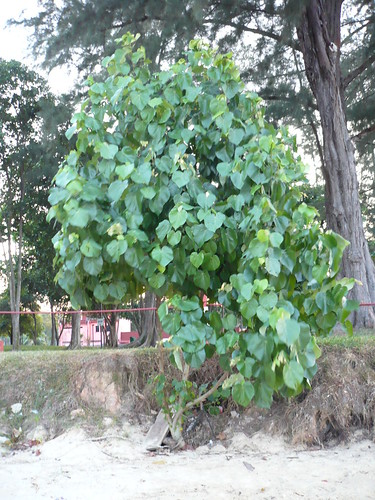
Such as this sea hibiscus (Hibiscus tiliaceus).
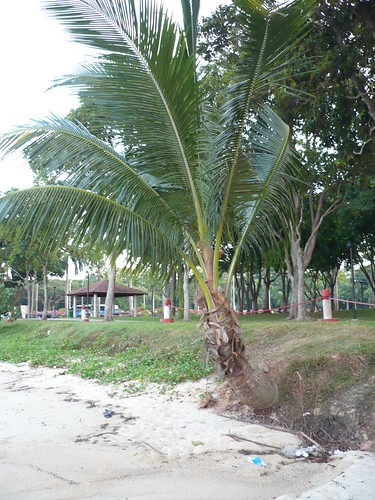
And this coconut palm (Cocos nucifera).
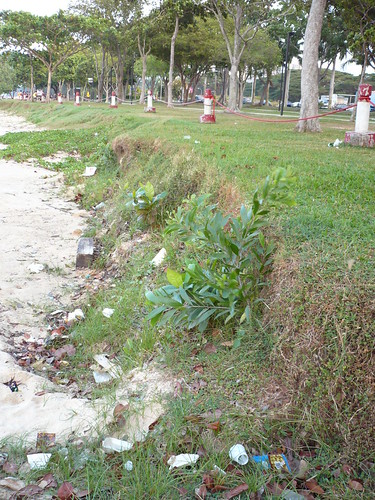
There's a small bunch of young sea almonds (Terminalia catappa).
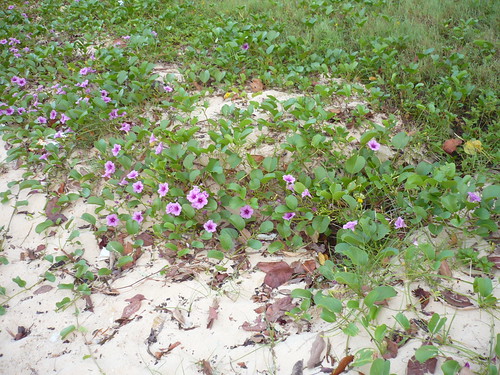
Seashore morning glory (Ipomoea pes-caprae) have colonised the beach in numbers, and many of these plants were in flower. Ria shares more details about this adaptable plant here.

Beautiful, aren't they?
It's nice to see a different side of East Coast, rich in marine life. Sometimes the only evidence you find comes from the remains that you find washed up on the beach. Empty shells, bits of leaves, and other remains often provide valuable clues that hint at unsurveyed marine ecosystems found further offshore.
Unfortunately, in this modern day, one has to sift through a lot of man-made trash in order to find these clues.